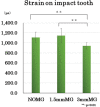Effects of Mouthguards on Skin Damage In Vitro Study
- PMID: 36307114
- PMCID: PMC10569882
- DOI: 10.1055/s-0042-1756474
Effects of Mouthguards on Skin Damage In Vitro Study
Abstract
Objective: Mouthguards can prevent and reduce orofacial sports traumas, which occur to the players themselves. However, the effect of mouthguards on skin damage has not been clarified. The present study's purpose was to examine whether the mouthguard can reduce or prevent skin damage caused by teeth (including the difference in mouthguard thickness).
Materials and methods: Pigskins, artificial teeth, and Ethylene-vinyl acetate (EVA) mouthguard blanks with 1.5- and 3.0-mm thickness were employed. Each of the two type mouthguards was produced in 10 replicates. Mouthguard incisal thickness and collision touch angle were measured on a PC using imaging software. A pendulum-type machine was used to apply impact. Strain gauges attached to the tooth and impacted plate were used to measure mouthguards' effect on impact stress. Also, a microscope was used to observe the after impacted skin condition, and the extent of damage was assessed as a score.
Results: The pigskin was ruptured in without mouthguard (NOMG) with presenting the highest damage score, whereas the complete rupture was not seen in the 1.5 mm MG, but the damage of the skin (defeat) was observed. No tissue change was found with the 3 mmMG. In both the flat plate and impact tooth strain, no significant difference was observed between NOMG and 1.5 mmMG. However, 3 mmMG had a significantly smaller value than the other two conditions. These results are likely to be strongly influenced by the mouthguard incisal thicknesses and collision touch angles differences.
Conclusion: The present study results clarified that two different thickness mouthguards reduced the skin damage, and the thicker mouthguard showed more effectiveness. Therefore, mouthguards may prevent the wearer's stomatognathic system's trauma and avoid damage to the skin of other athletes they are playing with. This effect seems to be an essential basis for explaining the necessity of using mouthguards for others besides full-contact sports.
The Author(s). This is an open access article published by Thieme under the terms of the Creative Commons Attribution License, permitting unrestricted use, distribution, and reproduction so long as the original work is properly cited. (https://creativecommons.org/licenses/by/4.0/).
Conflict of interest statement
None declared.
Figures





Similar articles
-
Does hard insertion and space improve shock absorption ability of mouthguard?Dent Traumatol. 2006 Apr;22(2):77-82. doi: 10.1111/j.1600-9657.2006.00361.x. Dent Traumatol. 2006. PMID: 16499630
-
[Custom-made mouthguards and prevention of orofacial injuries in sports].Acta Med Croatica. 2007;61 Suppl 1:9-14. Acta Med Croatica. 2007. PMID: 18949918 Croatian.
-
EVA mouthguards: how thick should they be?Dent Traumatol. 2002 Feb;18(1):24-7. doi: 10.1034/j.1600-9657.2002.180103.x. Dent Traumatol. 2002. PMID: 11841462
-
Mouthguards in sport activities : history, physical properties and injury prevention effectiveness.Sports Med. 2007;37(2):117-44. doi: 10.2165/00007256-200737020-00003. Sports Med. 2007. PMID: 17241103 Review.
-
Factors affecting sports-related orofacial injuries and the importance of mouthguards.Sports Med. 2014 Jun;44(6):777-83. doi: 10.1007/s40279-014-0167-9. Sports Med. 2014. PMID: 24647854 Review.
Cited by
-
Effect of Vinyl Acetate, Glass Fibers Contents, and Buffer Space on EVA's Mechanical Property and Shock Absorption Ability.Eur J Dent. 2024 Oct;18(4):1048-1061. doi: 10.1055/s-0044-1779427. Epub 2024 May 14. Eur J Dent. 2024. PMID: 38744336 Free PMC article.
References
-
- Fernandes L M, Neto J CL, Lima T FR et al.The use of mouthguards and prevalence of dento-alveolar trauma among athletes: a systematic review and meta-analysis. Dent Traumatol. 2019;35(01):54–72. - PubMed
-
- Lloyd J D, Nakamura W S, Maeda Y et al.Mouthguards and their use in sports: report of the 1st International Sports Dentistry Workshop, 2016. Dent Traumatol. 2017;33(06):421–426. - PubMed
-
- Black A M, Patton D A, Eliason P H, Emery C A. Prevention of sport-related facial injuries. Clin Sports Med. 2017;36(02):257–278. - PubMed
-
- Galic T, Kuncic D, Poklepovic Pericic T et al.Knowledge and attitudes about sports-related dental injuries and mouthguard use in young athletes in four different contact sports-water polo, karate, taekwondo and handball. Dent Traumatol. 2018;34(03):175–181. - PubMed
-
- Piccininni P, Clough A, Padilla R, Piccininni G. Dental and orofacial injuries. Clin Sports Med. 2017;36(02):369–405. - PubMed
LinkOut - more resources
Full Text Sources

